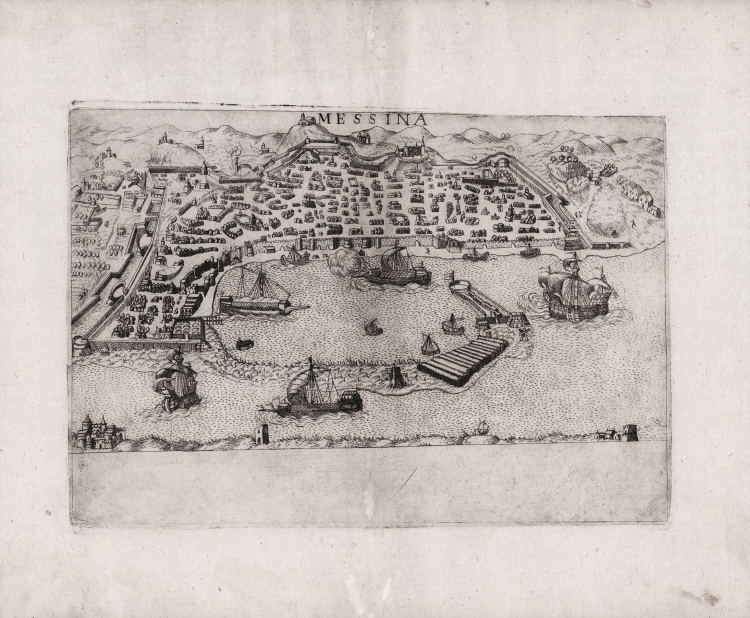



| Reference: | 4098 |
| Author | Paolo FORLANI |
| Year: | 1567 |
| Zone: | Messina |
| Printed: | Venice |
| Measures: | 270 x 193 mm |


| Reference: | 4098 |
| Author | Paolo FORLANI |
| Year: | 1567 |
| Zone: | Messina |
| Printed: | Venice |
| Measures: | 270 x 193 mm |
- SOLO DUE ESEMPLARI NOTI -
Anonima pianta prospettica della città, basata sul modello dell’Argaria, stampato a Roma dal Lafreri nello stesso anno (1567).
In alto al centro il titolo MESSINA. In basso lungo il bordo uno spazio vuoto che quasi certamente doveva contenere uno scritto o dei rimandi. Carta priva di orientazione e scala grafica.
Acquaforte e bulino, minimo restauro al centro perfettamnete eseguito, per il resto in eccellente stato di conservazione.
Attribuiamo la lastra a Paolo Forlani per la sua presenza nell’esemplare de "Il primo libro delle citta et fortezze principali del mondo" (edito a Venezia da Paolo Forlani nel 1567) conservato alla Österreichsche National bibliothek di Vienna.
Gli altri due esemplari conosciuti del libro del Forlani, che costituisce la prima raccolta di piante e vedute urbane del Rinascimento italiano, quello della collezione Hellwig e quello della Biblioteca di Wroclaw non contengono questa pianta di Messina.
Abbiamo censito un altro esemplare di questa mappa nella raccolta cinquecentesca della Biblioteca Marucelliana di Firenze.
MAGNIFICO ESEMPLARE DI QUESTA RARISSIMA PIANTA PROSPETTICA.
|
Ganado (1993): pp. 24, 34; cf. Valerio (1998): p. 40, n. 11.
|
Paolo FORLANI (Attivo a Venezia seconda metà del XVI secolo)
|
Paolo Forlani, a native of Verona, opened his own chalcographic workshop in Venice, Al segno del pozzo, in 1560, as reflected in some of his works. From 1566 he was active in Merzaria al segno della colonna and from 1569 in Merzaria al segno della nave. Forlani had business relationships with the major publishers of cartographic material of the time, among them Antonio Lafreri, the Bertelli family, and others. In addition to being a talented engraver, he was also quick to execute, a quality that enabled him to work for different publishers at the same time, and to execute a large amount of work. Woodward attributes about one hundred works to Forlani, most of which, however, are unsigned. Between 1560 and 1567, Forlani collaborated with Ferrando Bertelli, for whom he engraved about ten copperplates, with Camocio, Bolognino Zaltieri, and with Claudio Duchetti, for whom he engraved some maps. For his professional activity, however, the collaboration with Giacomo Gastaldi, for whom he engraved thirteen maps, was very important and valuable. In 1567 Forlani published and traded his work Il primo libro delle città et fortezze principali del mondo, whose branches later passed to Bolognino Zaltieri. It is likely that Forlani died during the plague that spread through Venice from 1575.
|
|
Ganado (1993): pp. 24, 34; cf. Valerio (1998): p. 40, n. 11.
|
Paolo FORLANI (Attivo a Venezia seconda metà del XVI secolo)
|
Paolo Forlani, a native of Verona, opened his own chalcographic workshop in Venice, Al segno del pozzo, in 1560, as reflected in some of his works. From 1566 he was active in Merzaria al segno della colonna and from 1569 in Merzaria al segno della nave. Forlani had business relationships with the major publishers of cartographic material of the time, among them Antonio Lafreri, the Bertelli family, and others. In addition to being a talented engraver, he was also quick to execute, a quality that enabled him to work for different publishers at the same time, and to execute a large amount of work. Woodward attributes about one hundred works to Forlani, most of which, however, are unsigned. Between 1560 and 1567, Forlani collaborated with Ferrando Bertelli, for whom he engraved about ten copperplates, with Camocio, Bolognino Zaltieri, and with Claudio Duchetti, for whom he engraved some maps. For his professional activity, however, the collaboration with Giacomo Gastaldi, for whom he engraved thirteen maps, was very important and valuable. In 1567 Forlani published and traded his work Il primo libro delle città et fortezze principali del mondo, whose branches later passed to Bolognino Zaltieri. It is likely that Forlani died during the plague that spread through Venice from 1575.
|